During a discussion with Guy Lerat Jr who shared his accompanying adventures with me, I learn that he is going to have to organize a important team building for one of his teams. Indeed, with the different entry/exit movements, the confinement period and the difficulty in releasing the budget for this type of activity, recreate the link became essential. So he didn't hesitate long when the opportunity presented itself!
After a few exchanges of ideas, I finally offered to help him build this workshop and co-host together, which he kindly accepted!
Here is in detail what we proposed and what really happened! 😉
Context
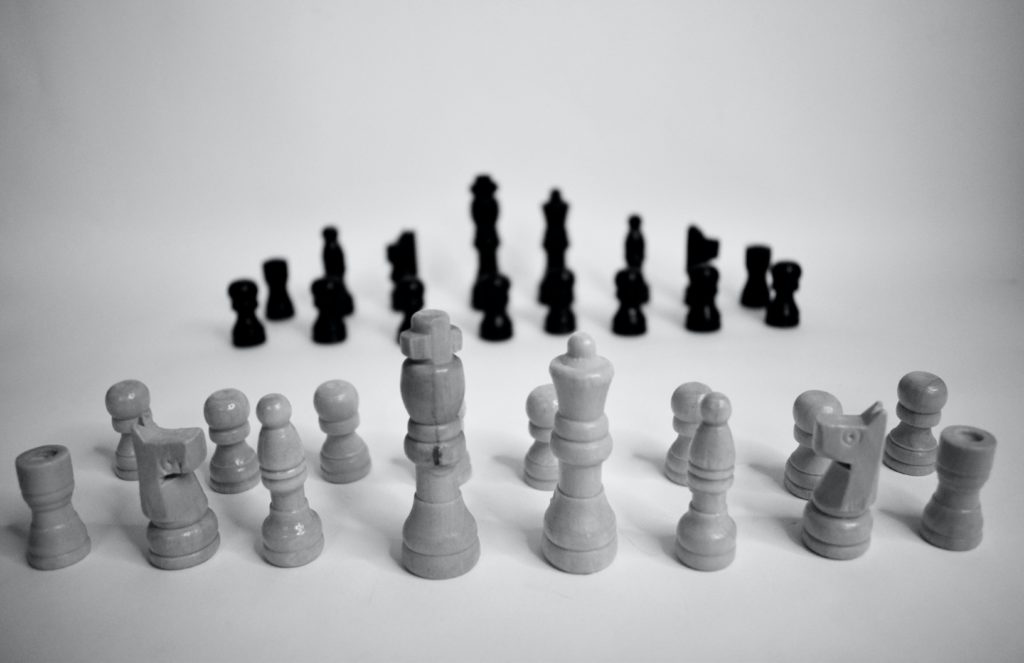
Here is the information with which I start my reflection:
- Number of persons : 11
- Duration : 3h
- Format : Face-to-face
- Intention : Recreate the link between team members and clean up certain conflicting relationships.
I therefore need a little more information on this last point. Indeed, the important thing for me is to have an idea of the existing tensions to avoid creating the spark that would ignite everything for the contrary build the relationship.
Note: I am not trying to avoid the problem but rather to put the fertile ground to its expression and resolution. This is what I put behind the notion of conflict prevention which I prefer to the notion of conflict management, but it remains a question of interpretation 🙂
What I quickly understand is that a new Product Owner has arrived, is under pressure and is relaying it to the team in different forms. He has not yet managed to find his place and he goes after a rather charismatic person who is appreciated by the team.
For the rest, the team is made up of varied profiles (tech / non-tech), from different companies.
Let's see what we can do from there! 😉
Design
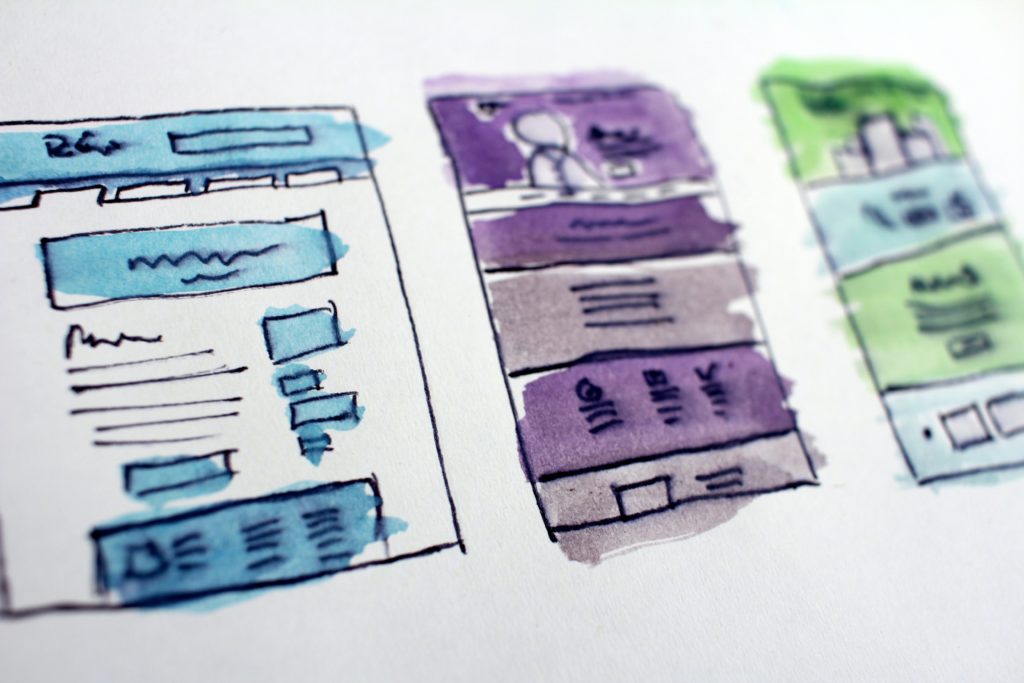
Let's start with the beginning. The time constraint is 3 hours, so we will start with a basic structure of the type: introduction, conclusion, a break and 2 work sections.
Guy shares with me that he had had the opportunity in the past to do a few workshops with them around the team: the Team Canvas and the speed boat are therefore removed from our list to avoid duplication.
What seems important to me in somewhat tense contexts such as this is to restore a human aspect to relationships what people weave together. By this I mean that people are more than their function and their role: they come from somewhere, they have passions, desires and things that make them unique. Those are Human being before being a job title! 🙂
Come on, let's keep it simple, cut to the chase, let's design!
Personal Map

I therefore propose to start with a workshop Personal Map, proposed by the Management 3.0 and inspired by heuristic maps or Mind Map. I particularly appreciate this exercise because it is simple and visual. You can easily set people in motion and create conversations, so it's a good activity to break the ice!
We thus open the ball by asking people to share a more personal view of who they are. This tends to create surprise and some curiosity at the others. We will therefore start from ourselves but our attention will go towards the discovery of the other.
Thus, in terms of animation, we can opt for several things:
- (10′) One first time individual construction of his Personal Map
- (15′) One Secondly sharing :
- in gallery mode where all the Personal Maps are displayed on the wall and where informal exchanges are created,
- or in Binomial mode for more intimate exchanges even if it means iterating several times.
Objectives, Obstacles, Risks

Since the training followed with Christopher Avery around the building high performing teams (which I might propose one day in French), I always keep in mind the notion of " common task to line up a team. What should we do together ? to what let's contribute all of us and who we outmoded ?
I also tend to say that it is in the difficulty in making connections with the others, which is why I propose to continue with a workshop around:
- of the Goals : to define this common task,
- of the Brakes : to expose the current difficulties,
- and Risks : to bring to collective consciousness the potential difficulties to come.
Note: Some will say that it's actually just an adapted Speed Boat, and I would tell them they're absolutely right! 😛 Jokes aside, the idea here is to focus the team forward (goal) and capitalize on the energy of frustration (barriers, risks) for moving forward together. All in one shorter time than a usual Speed Boat.
team name
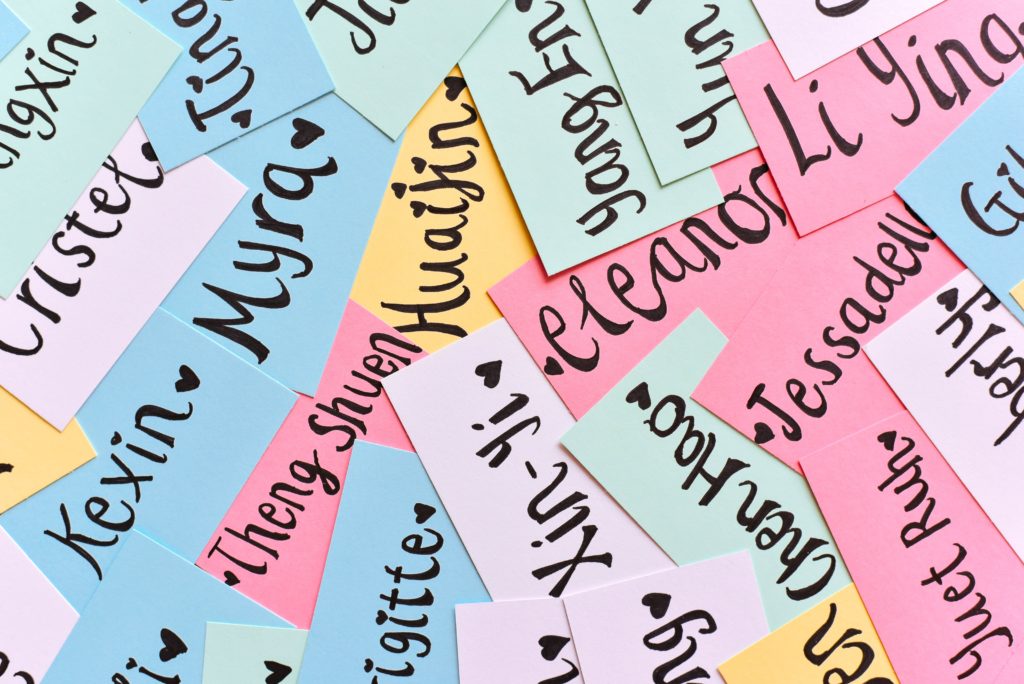
Guy tells me that discussing the name of the team again could be a good idea. Indeed, he had some requests in this direction and this could help to give new impetus.
I suggest that he take this part which will allow me to take a step back and prepare for the rest 🙂
Matrix Give and Take

During our exchanges, the subject of the Give and Take Matrix emerged several times. Indeed, this would make it possible to materialize in a more official way interactions between the different roles of the team.
However, I am well aware that we do not have the same way of apprehending the exercise. As Guy describes the matrix around the "what do I expect from you", I describe it on my side rather around the "what can i do for you". A notable nuance that obviously has its advantages and disadvantages.
He then offered me to animate this part to see the difference 🙂
Note: in short, in the first case we are more in an injunction (Obligation in the sense Responsibility Process) while in the second case we are more in a conscious choice (Responsibility in the sense Responsibility Process)
Summary and Timing

- (5′) Introduction
- (40′) Personal Map
- (45′) Objectives, Brakes, Risks
- (10′) Break
- (10′) Team name
- (45′) Give and Take Matrix
- (10′) Closing
Actual progress
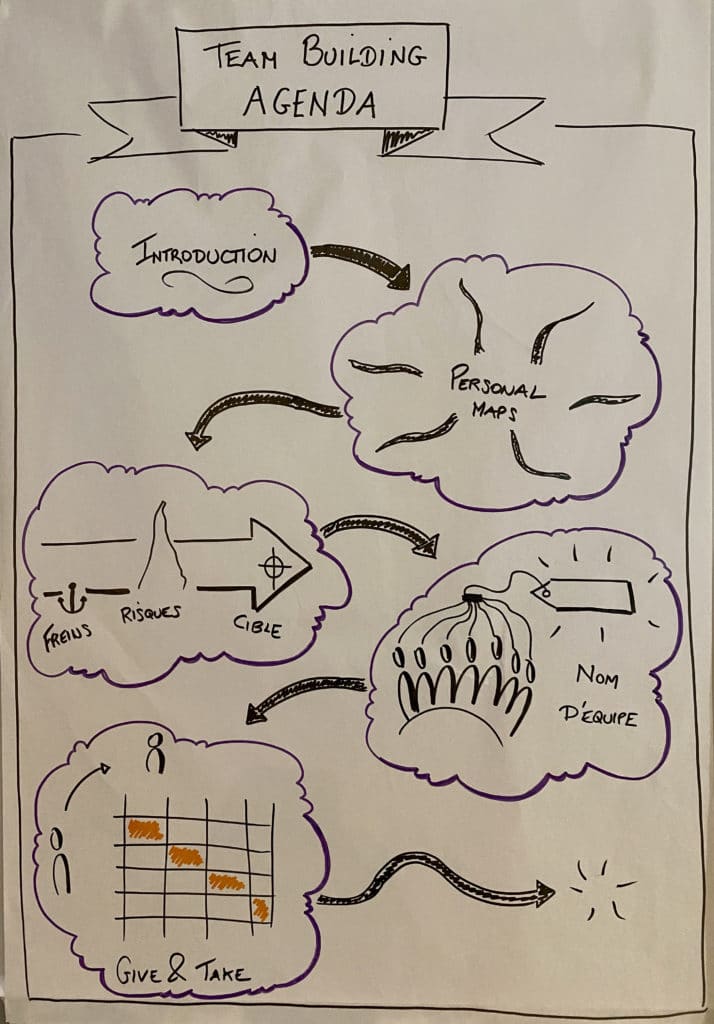
The big day finally arrives. Guy gives me an appointment at 9am and tells me that he wouldn't be surprised if we were the first. Ah. From the start, we know that things will have to be readjusted. The question that arises is therefore: at what point ?
9:00 : Indeed, there are only 4 of us. I take advantage of the time available to prepare a few posters and get to know the 2 people who are there.
9:30 : 2-3 people arrive drop by drop and we learn that the rest of the group is in the same car. They expect to arrive around 10 a.m.
Animation editing
A readjustment is therefore necessary, we have already lost 1/3 of the time available. I suggest to Guy that we keep the Personal Map at first, which we will adapt according to how the group reacts.
I am going to simplify the sequence Objectives, Obstacles, Risks to save some time while staying focused on the original intention: consolidate the group. To do this, we will only do the part Goals, so that everyone is well aware of what they are contributing to and that they have the opportunity to realign themselves if necessary.
Arrival of latecomers
10:10 : The rest of the group finally arrives, with a lot of energy and excitement. I watch the group carefully as Guy tries to get everyone together to get started.
Indeed, people are quite dissipated and one joke leading to another, it is still difficult to channel them.
Nevertheless, we start with our first sequence.
Personal Map
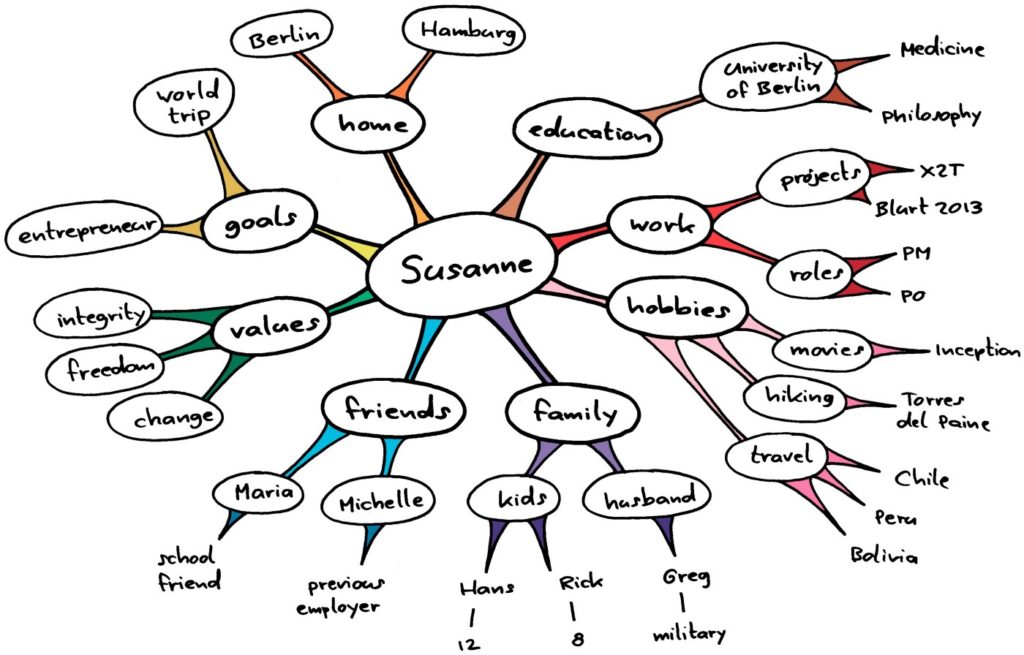
After preparing an example on a Flipchart sheet, we explain the concept to the participants. In the form of a Mindmap, we invite them to share around different themes that concern them: their objectives, their values, their family, their hobbies, their training...
Remarks emerge from some people in the group:
we tell our life what!
What I think is important to clarify these 2 things:
- The objective is indeed to share information which slightly beyond the professional sphere because beyond what you do, you are a whole person !
- Now it's up to you how much information and detail you want to share. There is no particular constraints or obligations !
Note: It seemed important to me to restore a frame exercise to get the group moving. And that by staying in the invite and not the uncomfortable injunction.
We then let each person work individually for 10 minutes.
Pair work
While everyone is developing their Personal Map, we quickly discuss with Guy the fact that pair interviews could really be valuable. We are therefore heading in this direction for a first round.
At the end of the 10 minutes, we decide to continue with the interview in pairs with the following instructions:
We suggest that you pair up, exchange your Personal Maps and chat for a few minutes together
Note: I insist on separating the pairs well to create a more intimate environment and therefore more conducive to personal sharing.
Facilitation
The facilitation here is quite simple because you just have to pass by each group to see how the exchanges are going:
- Are there any surprises?
- Any emerging commonalities?
- What is the atmosphere in this relationship for two?
Too directive?
We exchange quickly on this subject because wishing to do well, he wonders about being directive in this way. I tell him that from my point of view it is not embarrassing if the intention is clear and that this is limited in time.
Indeed, the constraint makes it possible to create the space of learning and interaction which could not perhaps take place otherwise.
The idea here is to keep in mind that nothing is all black or all white. What matters most is maximize profits of our choice andlimit the disadvantages ! 🙂
Note: you can go see my article around the Polarity Management for more details.
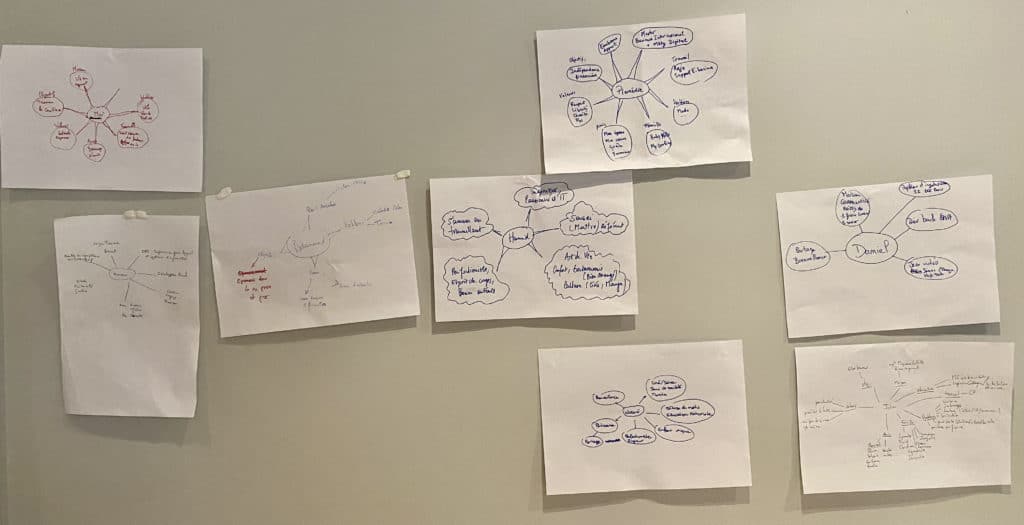
After these few interviews for 2, we proposed to the group to display their Personal Map on the wall in Gallery mode. This way, everyone can complete their vision of the group when they want 🙂
Goals

We then move on to the sequence around the Objective. It's not always an easy exercise and requires everyone to position themselves and look away. We can also see that the "far away" is not the same distance for everyone, which is totally ok 🙂
I allow myself then to add an additional element. In addition to the team objective, I ask them to think about the reason for this objective. What will achieving this goal contribute to?
Facilitation
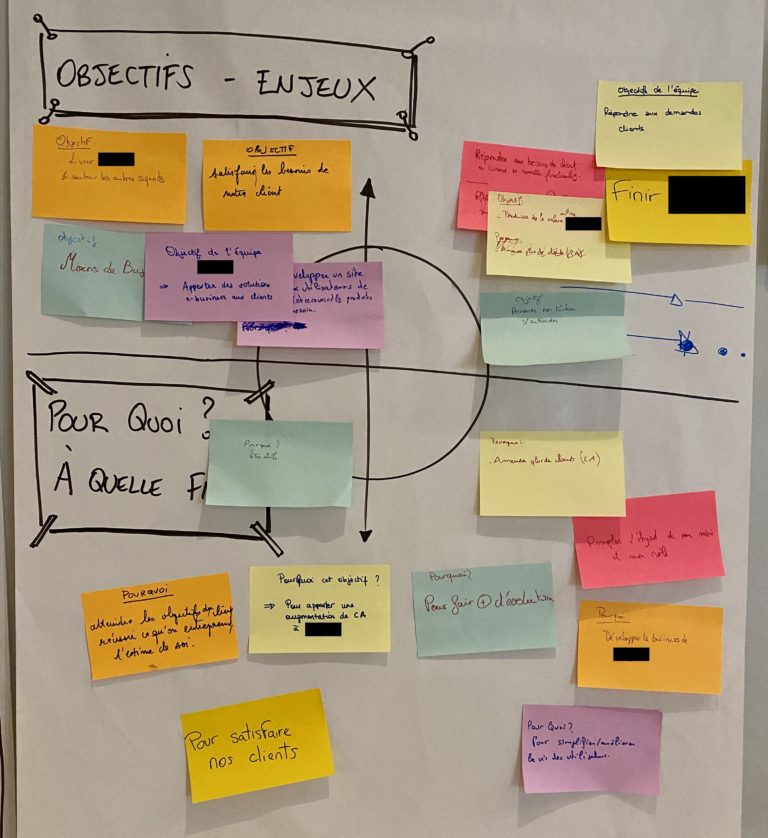
Description of the objective
After a few minutes of individual reflection on Post-it notes, we go through each person one by one for the description of the objective. As expected, we do see a wide disparity in the responses.
There are objectives of quite different scopes.
More distant like:
Meet the needs of our customers
And more down to earth like:
Deliver such project
Produce fewer bugs
Ensure our tasks
It's this diversity of visions that we are trying to materialize and this already makes it possible to generate some exchanges around this common task to the team.
Intent of the goal
We then move on to the 2nd part around the intention of the objective itself.
Again, there is some diversity in the responses, but one in particular caught my attention:
Reach the client's objectives to succeed in what we undertake and thus nurture a certain self-esteem.
This answer seems interesting to me on 2 levels:
- The content of the response shows a certain retreat and a quest that goes beyond simply performing a job
- The person who voiced it tended to behave a bit like a jerk from the start. Her energy then changed from here it became more present and more focused.
Note: I tend to believe that putting down the subject of “why” allows everyone to give perspective to their work, both individually and collectively. This allows the group to build itself through the diversity of visions and to create this common awareness of everyone's position, without judgement.
After a few exchanges, we move on because our time is limited!
team name
A team's name helps build its identity. With the team having seen people in and out over the past few months, the question of whether their name still fits them makes sense.
Guy then takes care of this sequence:
- It offers each person to write on post-its up to 3 team names
- We gather all the ideas on Flipchart
- We vote to bring out a top 3
- Then he proposes one of the remaining names which he objects to
Note: I proposed here to use consent (nobody against) rather than consensus (everyone is for) to save some time
Surprisingly enough, despite a request from some people, the band's choice fell on the current name of the team.
This will at least have had the merit of having been a collective choice this time! 🙂
We therefore quickly move on to the following sequence: the give and take matrix.
Matrix Give and Take
I discovered the give and take matrix in the book Gamestorming. I particularly appreciate this exercise because it is a great conversation starter.
Indeed, it allows to build the relationship framework between different parties on the basis of a mutual exchange. In my case, I direct the exchanges on the needs and how each can respond to it.
Phase 0: Initialization
So I quickly build the matrix with the different roles represented in the group:
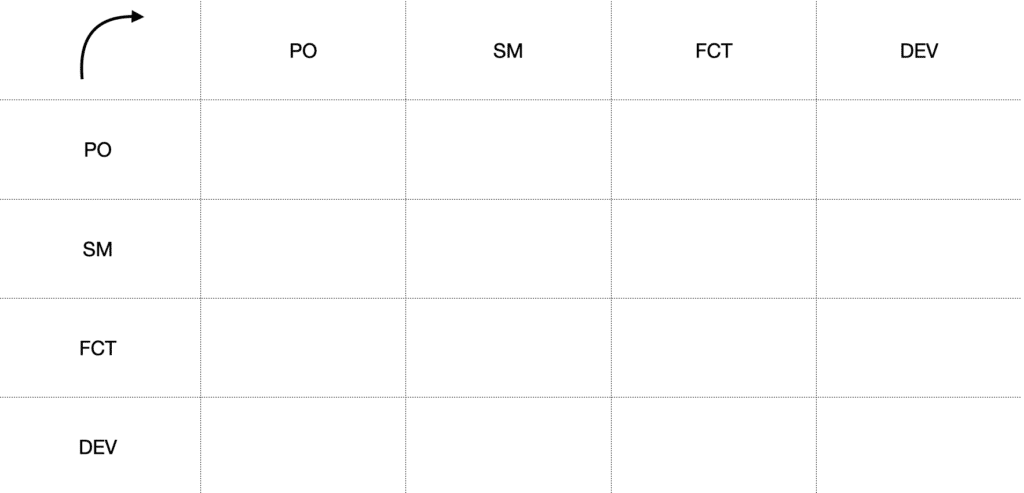
So here we have 4 roles: Product Owner (PO), Scrum Master (SM), Functional (FCT) and Developer (DEV). I arrange them as above, vertically and horizontally, in the same order. The arrow indicates the reading direction: the role in vertical "gives" to the role in horizontal.
Phase 1: Needs
In this phase, I will ask each role to come and fill in “its” box.
The latter corresponds to what the role gives itself. This has been translated as its needs to be able to carry out its mission as well as possible.
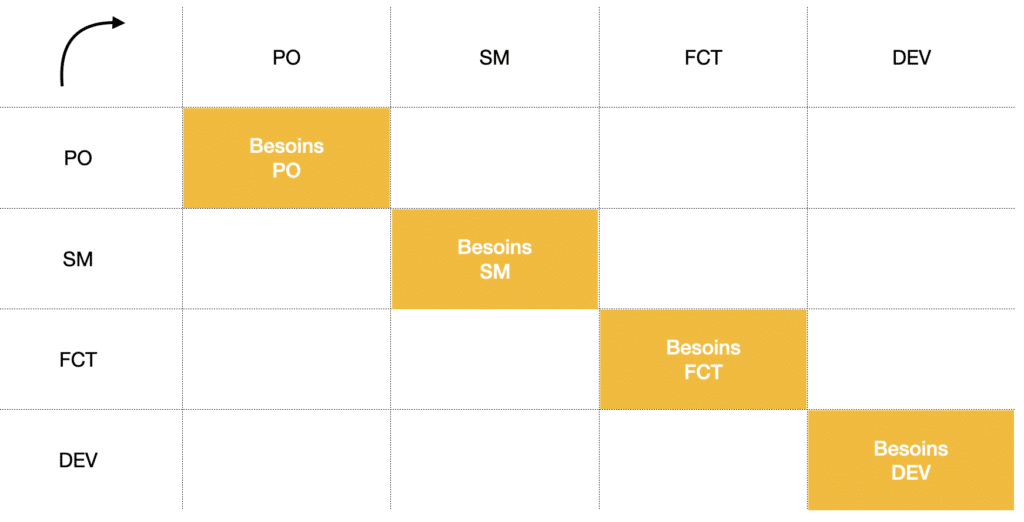
We are talking here about needs corresponding to roles and not to people. Thus, the roles represented by several people must be the expression of the associated collective.
This was the case for the FCTs and the DEVs, who each had to work in a group to define their needs.
Facilitation
After a few minutes of reflection, I ask each role to come and put their post-it in their box, explaining to the rest of the group each element that is written there.
Note: I agree here to deviate from the “one idea, one post-it” rule for the sake of space on the matrix. However, we will be able to use this to our advantage later 😉
The work of facilitation here is mainly in the distribution of the floor. I simply ensure that each need is properly understood by the rest of the group by questioning or the rewording.
From conflict to empathy
A notable element occurs in the interaction of the group during the presentation of the PO's needs. Indeed, after his intervention, the PO is questioned by the DEVs who consider that elements are missing and therefore that he has other needs to satisfy!
While these people tended to be in opposition usually, we then see them in co-construction and in empathy towards each other. The sauce seems to take and this is encouraging!
The energy of the group is more channeled only at the beginning and we feel that everyone is focused on listening the other.
Phase 2: Filling
When all the roles are passed, I invite each person to come and see how they can contribute to satisfying their needs. Most of the time, I suggest that people get up and move closer to the board, which tends to generate the first discussions.

After about fifteen minutes, we see that the matrix has filled up. I then propose a last passage to see if all the needs have been satisfied or not.
Each role then comes back in turn and checks off the needs met on its post-it. This is the interest of having everything concentrated on the same post-it, we directly have the synthesis we are looking for 🙂
The fact that not all needs are met is not necessarily a problem. Indeed, this allows the group to have the following conversations:
- Do we have the right people here to meet this need?
- Are clarifications needed?
- How can we collectively meet this need?
We again see the power of exercise as a conversation starter. The exchanges come naturally, the discussions are a mixture of curiosity and the search for solutions.
Thus, we restore a little structure to the interactions between the roles as well as an overall vision that can be reused in the future.
Indeed, it is an evolving work that could be a support for a future retrospective 😉
Conclusion

The animation of this workshop was full of surprises! It took readjust the content in real time taking into account the learning of the group over time.
We have achieved the objectives of this collective moment: strengthen ties between people and put them in a co-construction approach. People in tension even found commonalities 🙂
There give and take matrix is an extremely powerful tool for having structuring conversations between roles. It gives a warmer aspect to the exercise so appreciated by organizations " roles and responsibilities“, by putting people and their needs back at the centre.
Thanks to Guy for trusting me and letting me co-host with him 🙂







2 responses
top ! thank you so much for sharing!
Once again thank you ! THANKS ! THANKS !
When I need clarity and something complete between tool theory, concrete applications and REX, I know where to go.
I really like the structure of your articles, it's really helpful.